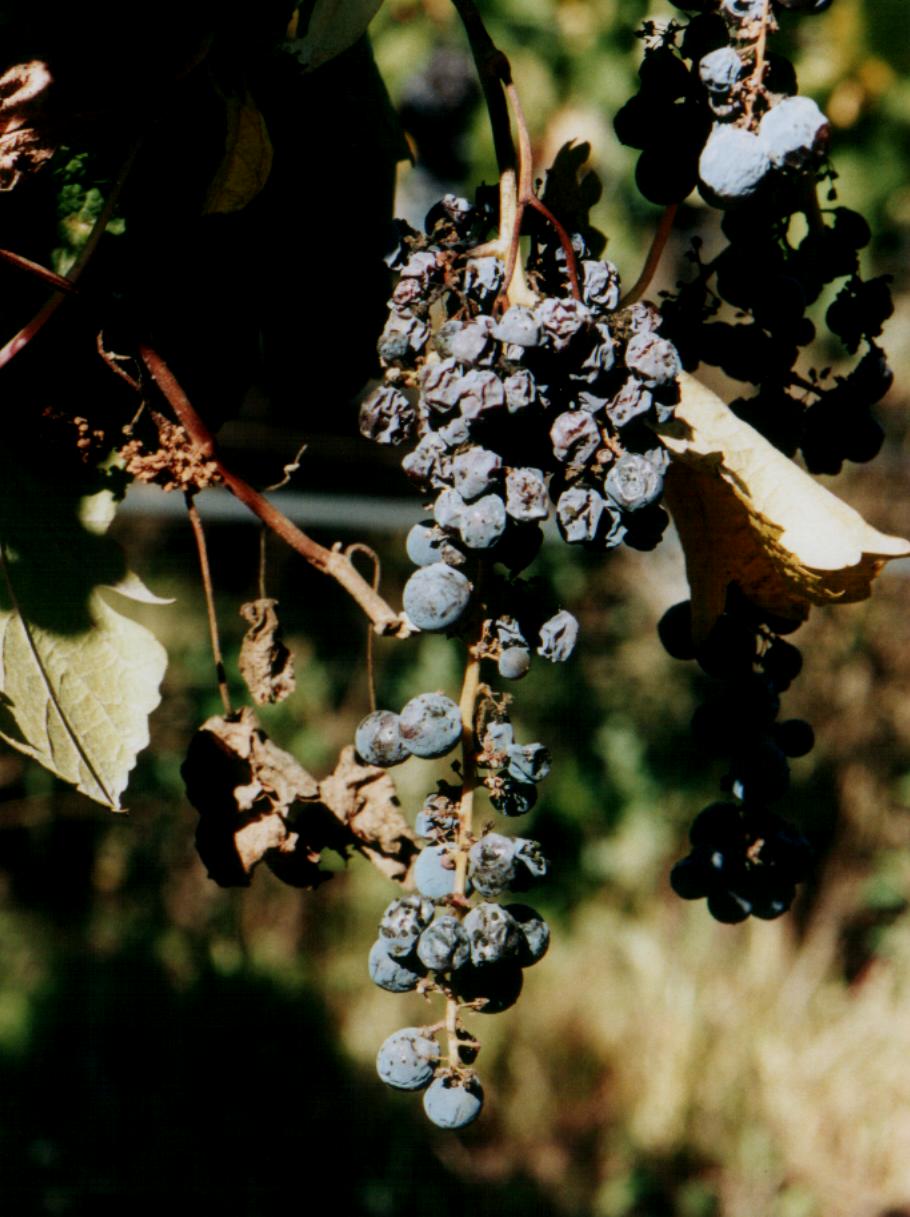Universidad de Chile, Facultad de Ciencias Agronómicas, Departamento de Sanidad Vegetal, Avenida Santa Rosa 11315, La Pintana, Santiago, Chile
Introduction
Grapevine (Vitis vinifera L.) is widely grown in Chile where the vineyards cover 145,873 and 52,234 hectares of wine and table grape varieties, respectively. The main wine grape varieties are Cabernet Sauvignon, Merlot, Carménère, Chardonnay, Sauvignon blanc and Syrah, whereas the prevailing table grape cultivars are Thompson Seedless, Red Globe, Flame Seedless, Crimson Seedless and Superior (CIREN 2014; ODEPA 2016). The relatively rapid expansion of the acreage given over to grapevines and a limited health certification program have resulted in the extensive spreading of various diseases including those associated with the presence of phytoplasmas known as grapevine yellows (GY).
Grapevine Yellows disease
The presence of GY disease in V. vinifera in Chile was reported in 1971 based on observation of symptoms; however, the first laboratory evidence for the presence of phytoplasmas in grapevine occurred in the early 2000’s by electron microscopy and molecular tools (Gajardo et al., 2003; Herrera and Madariaga, 2003; Bertaccini et al., 2004). To date phytoplasmas belonging to six ribosomal subgroups have been identified in grapevine in Chile (16SrI-B, 16SrI-C, 16SrIII-J, 16SrV-A, 16SrVII-A and 16SrXII-A) (Gajardo et al., 2009; Fiore et al., 2015b), but there is no information about their prevalence in vineyards. The symptoms generally observed are downward rolling of leaves, incomplete shoot lignification, drying up of bunches and plant decline, with reddening and yellowing of leaves in red and white varieties, respectively (Figures 1 and 2). The 16SrIII-J subgroup is the most widespread phytoplasma in Chile, infecting not only grapevine but also several other woody and herbaceous species (González et al., 2011; Fiore et al., 2015b; Quiroga et al., 2015; 2017a), and its draft genome sequence is now available (Zamorano and Fiore, 2016).

Transmission trials have shown that Paratanus exitiosus and Bergallia valdiviana can transmit this phytoplasma to both periwinkle [Catharanthus roseus (L.) G. Don] and grapevine (Quiroga et al., 2018). P. exitiosus and B. valdiviana are widely distributed throughout the country, and they are commonly captured on weeds in Chilean vineyards and occasionally feed on grapevine plants (Fiore et al., 2015a; Quiroga et al., 2015). Scaphoideus titanus has never been found in Chile; however, recent studies have indicated that both current and projected climate change conditions in the central zone of Chile are appropriate for its survival and settlement (Quiroga et al., 2017b). The leafhoopper Amplicephalus curtulus, detected harboring 16SrI-B and 16SrXII-A phytoplasmas, has been frequently captured in weeds present in Chilean vineyards, but it has not been possible to determine whether it transmits these phytoplasmas to the grapevines (Longone et al., 2011).
Some weeds present in or around the vineyards have been found positive for some phytoplasmas also detected on the grapevine. Specifically Galega officinalis infected with 16SrVII-A phytoplasma, Convolvulus arvensis (16SrI-B, 16SrVII-A and 16SrXII-A), and Polygonum aviculare (16SrI-B and 16SrVII-A) (Longone et al., 2011). It is important to note that C. arvensis plays a fundamental role in the epidemiology of the 16SrXII-A phytoplasma, responsible for “bois noir” disease, which in Europe is mainly transmitted by the Cixiidae Hyalesthes obsoletus, not reported in Chile.

REFERENCES
Bertaccini A, Botti S, Fiore N, Gajardo A, Montealegre J (2004) Identification of a new phytoplasma(s) infecting grapevine with yellows in Chile. In: Abstract of XV Meeting of IOM, Athens, GA, USA 37:63-64.CIREN (2014) Evolución superficie frutícola nacional y sus principales especies. http://bibliotecadigital.ciren.cl/handle/123456789/1226
Fiore N, Longone V, Gonzalez X, Zamorano A, Pino AM, Quiroga N, Picciau L, Alma A, Paltrinieri S, Contaldo N, Bertaccini A (2015a) Transmission of 16SrIII-J phytoplasma by Paratanus exitiosus (Beamer) leafhopper in grapevine. Phytopath Moll 5:S43–S44.
Fiore N, Zamorano A, Pino AM (2015b) Identification of phytoplasmas belonging to the ribosomal groups 16SrIII and 16SrV in Chilean grapevines. Phytopath Moll 5:32–36.
Gajardo A, Botti S, Montealegre J, Fiore N, Bertaccini A (2003) Survey and phytoplasmas identified in Chilean grapevines.- In: Extended abstracts 14th Meeting of the International Council for the Study of Virus and Virus-like Diseases of the Grapevine (ICVG) - Locorotondo (BA), Italy, pp 85-86.
Gajardo A, Fiore N, Prodan S, Paltrinieri S, Botti S, Pino AM, Zamorano A, Montealegre J, Bertaccini A (2009) Phytoplasmas associated with grapevine yellows disease in Chile. Plant Dis 93:789–796.
González F, Zamorano A, Pino AM, Paltrinieri S, Bertaccini A, Fiore N (2011) Identification of phytoplasma belonging to X-disease group in cherry in Chile. Bull Insectol 64(Suppl):S235–S236.
Herrera G, Madariaga M (2003) Evidencias inmunológicas, microscópicas y moleculares de la presencia de fitoplasmas en vides. Agricultura Técnica 63:15-22
Longone V, Gonzáles F, Zamorano A, Pino AM, Araya J, Díaz V, Paltrinieri S, Calari A, Bertaccini A, Picciau L, Alma A, Fiore N (2011) Epidemiological aspects of phytoplasmas in Chilean grapevines. Bull of Insectol 64(Suppl):S91-S92.
ODEPA (2016) Catastro Vitícola Nacional SAG. https://www.odepa.gob.cl/wp-content/uploads/2018/03/catastro-vides-2017.pdf
Quiroga N, González X, Zamorano A, Pino AM, Picciau L, Alma A, Paltrinieri S, Contaldo N, Bertaccini A, Fiore N (2015) Transmission of 16SrIII-J phytoplasma by Bergallia valdiviana Berg 1881 leafhopper. Phytopath Moll 5(1-Suppl):S47–S48.
Quiroga N, Bustamante M, Gamboa C, Molina J, Zamorano A, Fiore N (2017a) 16SrIII-J phytoplasmas infecting lettuce and Swiss chard crops in Chile. Phytopath Moll 7(2):91-94..
Quiroga N, Ivulic D, Lagos J, Saavedra M, Sandoval-Rodríguez A, Infante R, Morales L, Fiore N (2017b) Risk analysis of the establishment of Scaphoideus titanus, vector of “flavescence dorée” phytoplasma in grapevine, under current and estimated climate change conditions in Chile. Phytopath Moll 7(1):39-44.
Quiroga N., Longone V, González X, Zamorano A, Pino AM, Picciau L, Alma A, Paltrinieri S, Contaldo N, Bertaccini A, Fiore N (2018) Transmission of 16SrIII-J phytoplasmas by Paratanus exitiousus (Beamer) and Bergallia valdiviana Berg 1881 leafhoppers.Phytopath. Medit. (submitted).
Zamorano A, Fiore N (2016) Draft genome sequence of 16SrIII-J phytoplasma, a plant pathogenic bacterium with a broad spectrum of hosts. Gen Announc 4(3):e00602-16.

